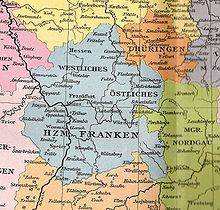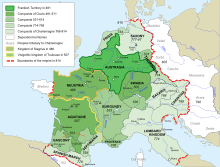Duchy of Franconia
Duchy of Franconia Herzogtum Franken (German) | |||||||||||||
|---|---|---|---|---|---|---|---|---|---|---|---|---|---|
| 906–1168 | |||||||||||||
| Status | Roman Catholic (official) Germanic paganism | ||||||||||||
| Government | Feudal Duchy | ||||||||||||
| History | |||||||||||||
• Established | 906 | ||||||||||||
• Disestablished | 1168 | ||||||||||||
| |||||||||||||
| Today part of | Germany | ||||||||||||

The Duchy of Franconia (
Geography
It stretched along the valley of the River
Located in the centre of what was to become the German kingdom about 919, it bordered the stem
History

The duchy evolved during the decline of the Carolingian Empire, when it was a part of the core Frankish realm of Austrasia (i.e. "Eastern Francia"), and got its form when the northwestern parts of Austrasia became a new realm called Lotharingia.
Unlike the other stem duchies, Franconia did not evolve into a stable political entity, though the local
The Salian counts in Rhenish Franconia were sometimes mentioned as Franconian dukes and they became Germany's royal and imperial dynasty in 1024. In 1093 their Franconian territories were granted as a fief to the
Emperor Conrad II was last to bear the ducal title. When he died in 1039, Rhenish Franconia was governed as a constellation of small states, including the cities of
As of the 13th century, the following states, among others, had formed in the territory of the former Duchy:
|
|
Dukes
- Henry(882–92), as "Margrave of the Franks" (marchio francorum) and "Duke of the Austrasians" (dux austrasiorum)
- Conrad the Elder (died 906) is sometimes treated retrospectively as the ruler of Franconia
- Conrad I, the Younger (906–18), also King of Germany from 911
- Eberhard (918–39)
- Otto of Worms (985–1004), called "duke of the Franks of Worms" (Wormatiensis dux Francorum)[2]
- Conrad, son of prec., titled "duke of Worms"[2]
- ...
- Frederick (died 1105), called himself "Duke of Franconia" towards his death[citation needed]
- Conrad II (1116–25), titled "duke of the East Franks" (dux Francorum orientalium)[3]
In 1168 the duchy of Franconia was bestowed by the
References
- ^ a b Chisholm 1911, p. 15.
- ^ a b Jackman 1990, p. 96.
- ^ Lyon 2012, p. 37.
Sources
- One or more of the preceding sentences incorporates text from a publication now in the public domain: Chisholm, Hugh, ed. (1911). "Franconia". Encyclopædia Britannica. Vol. 11 (11th ed.). Cambridge University Press. p. 15.
- Franken. In: Meyers Konversations-Lexikon. 4th edition. Volume 6, Verlag des Bibliographischen Instituts, Leipzig/Vienna 1885–1892, p. 491.
- Jackman, Donald C. (1990). The Konradiner: A Study in Genealogical Methodology. Frankfurt: Vittorio Klostermann.
- Lyon, Jonathan R. (2012). Princely Brothers and Sisters: The Sibling Bond in German Politics, 1100–1250. Cornell University Press.

